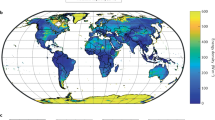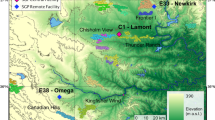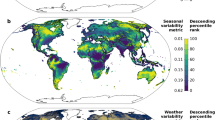Abstract
The wind industry in the United States has experienced a remarkably rapid expansion of capacity in recent years and this fast growth is expected to continue in the future1,2,3. While converting wind’s kinetic energy into electricity, wind turbines modify surface–atmosphere exchanges and the transfer of energy, momentum, mass and moisture within the atmosphere4,5,6. These changes, if spatially large enough, may have noticeable impacts on local to regional weather and climate. Here we present observational evidence for such impacts based on analyses of satellite data for the period of 2003–2011 over a region in west-central Texas, where four of the world’s largest wind farms are located7. Our results show a significant warming trend of up to 0.72 °C per decade, particularly at night-time, over wind farms relative to nearby non-wind-farm regions. We attribute this warming primarily to wind farms as its spatial pattern and magnitude couples very well with the geographic distribution of wind turbines.
This is a preview of subscription content, access via your institution
Access options
Subscribe to this journal
Receive 12 print issues and online access
$209.00 per year
only $17.42 per issue
Buy this article
- Purchase on Springer Link
- Instant access to full article PDF
Prices may be subject to local taxes which are calculated during checkout



Similar content being viewed by others
References
American Wind Energy Association AWEA 4th Quarter 2011 Public Market Report (AWEA, 2012); available at http://awea.org/learnabout/publications/reports/upload/4Q-2011-AWEA-Public-Market-Report_1-31.pdf.
American Wind Energy Association US Wind Energy Market Update (AWEA, 2011); available at http://www.awea.org/learnabout/publications/factsheets/upload/Market-Update-Factsheet-Final_April-2011.pdf.
US Department of Energy 20% Wind by 2030 (USDOE, 2008); available at http://www1.eere.energy.gov/wind/pdfs/42864.pdf.
Knippertz, P., Ulbrich, U. & Speth, P. Changing cyclones and surface wind speeds over the North Atlantic and Europe in a transient GHG experiment. Clim. Res. 15, 109–122 (2000).
Simmonds, I. & Keay, K. Surface fluxes of momentum and mechanical energy over the North Pacific and North Atlantic oceans. Meteorol. Atmos. Phys. 80, 1–18 (2002).
Baidya, R. S. & Traiteur, J. J. Impacts of wind farms on surface air temperatures. Proc. Natl Acad. Sci. USA 107, 17899–17904 (2010).
Combs, S. The Energy Report 2008 (Texas Controller of Public Accounts, 2008); available at http://www.window.state.tx.us/specialrpt/energy/.
Keith, D. et al. The influence of large-scale wind power on global climate. Proc. Natl Acad. Sci. USA 101, 16115–16120 (2004).
Kirk-Davidoff, D. B. & Keith, D. W. On the climate impact of surface roughness anomalies. J. Atmos. Sci. 65, 2215–2234 (2008).
Sta Maria, M. R. V. & Jacobson, M. Z. Investigating the effect of large wind farms on energy in the atmosphere. Energies 2, 816–838 (2009).
Barrie, D. & Kirk-Davidoff, D. Weather response to management of large wind turbine array. Atmos. Chem. Phys. 10, 769–775 (2010).
Wang, C. & Prinn, R. J. Potential climatic impacts and reliability of very large-scale wind farms. Atmos. Chem. Phys. 10, 2053–2061 (2010).
Fiedler, B. H. & Bukovsky, M. S. The effect of a giant wind farm on precipitation in a regional climate model. Environ. Res. Lett. 6, 045101 (2011).
Baidya, R. S., Pacala, S. W. & Walko, R. L. Can large scale wind farms affect local meteorology? J. Geophys. Res. 109, D19101 (2004).
Adams, A. S. & Keith, D. W. Wind energy and climate: Modeling the atmospheric impacts of wind energy turbines. Eos Trans. AGU 88 (Fall Meeting Suppl.), abstr. B44B-08 (2007).
Baidya, R. S. Simulating impacts of wind farms on local hydrometeorology. J. Wind Eng. Ind. Aerodyn.http://dx.doi.org/10.1016/j.jweia.2010.12.013 (in the press).
Jin, M. & Dickinson, R. E. New observational evidence for global warming from satellite. Geophys. Res. Lett. 29, 1400 (2002).
Wan, Z. New refinements and validation of the MODIS land surface temperature/emissivity products. Remote Sens. Environ. 112, 59–74 (2008).
Schaaf, C. B. et al. First operational BRDF, albedo, and nadir reflectance products from MODIS. Remote Sens. Environ. 83, 135–148 (2002).
Gallo, K. P. & Owen, T. K. Satellite-based adjustments for the urban heat island temperature bias. J. Appl. Meteorol. 36, 1117–1132 (1997).
Dai, A., Trenberth, K. E. & Karl, T. R. Effects of clouds, soil moisture, precipitation, and water vapor on diurnal temperature range. J. Clim. 12, 2451–2473 (1999).
Zhou, L. et al. Spatial patterns of diurnal temperature range trends on precipitation from 1950 to 2004. Clim. Dynam. 32, 429–440 (2009).
Zhou, L., Dickinson, R. E., Tian, Y. & Vose, R. S. Impact of vegetation removal and soil aridation on diurnal temperature range in a semiarid region—application to the Sahel. Proc. Natl Acad. Sci. USA 104, 17937–17942 (2007).
Denholm, P., Hand, M., Jackson, M. & Ong, S. Land-use Requirements of Modern Wind Power Plants in the United States Technical Report NREL/TP-6A2-45834 (2009); available at http://www.nrel.gov/docs/fy09osti/45834.pdf.
Friedl, M. A. et al. MODIS Collection 5 global land cover: Algorithm refinements and characterization of new datasets. Remote Sens. Environ. 114, 168–182 (2010).
Zhou, L. et al. A sensitivity study of climate and energy balance simulations with use of satellite derived emissivity data over the northern Africa and the Arabian peninsula. J. Geophys. Res. 108, 4795 (2003).
Eastman, J. L., Coughenour, M. B. & Pielke, R. A. The effects of CO2 and landscape change using a coupled plant and meteorological model. Glob. Change Biol. 7, 797–815 (2001).
Stull, R. B. An Introduction to Boundary Layer Meteorology 9–19 (Springer, 2009).
Liu, J. et al. Validation of MODIS albedo retrieval algorithm: Dependence of albedo on solar zenith angle. Remote Sens. Environ. 114, 738–760 (2010).
Dee, D. P. et al. The ERA-interim reanalysis: Configuration and performance of the data assimilation system. Q. J. R. Meteorol. Soc. 137, 553–597 (2011).
Mesinger, F. et al. North American regional analysis. Bull. Am. Meteorol. Soc. 87, 343–360 (2006).
Acknowledgements
This study was supported by the startup financial support provided by the University at Albany, State University of New York and by the National Science Foundation (NSF IPA no. 0824354). The ECMWF interim reanalysis data is obtained from the ECMWF data server. The NARR reanalysis data is provided by the National Oceanic and Atmospheric Administration/National Centers for Environmental Prediction/Environmental Modeling Center.
Author information
Authors and Affiliations
Contributions
L.Z. and Y.T. contributed the central idea, carried out data analyses, prepared the data and figures and wrote the initial draft of the paper. The remaining authors contributed to refining the ideas and to writing this paper.
Corresponding author
Ethics declarations
Competing interests
The authors declare no competing financial interests.
Supplementary information
Rights and permissions
About this article
Cite this article
Zhou, L., Tian, Y., Baidya Roy, S. et al. Impacts of wind farms on land surface temperature. Nature Clim Change 2, 539–543 (2012). https://doi.org/10.1038/nclimate1505
Received:
Accepted:
Published:
Issue Date:
DOI: https://doi.org/10.1038/nclimate1505
This article is cited by
-
An evaluation of WRF urban canopy models over Bengaluru, India
Modeling Earth Systems and Environment (2024)
-
Co-benefits of carbon neutrality in enhancing and stabilizing solar and wind energy
Nature Climate Change (2023)
-
The impact of wind energy on plant biomass production in China
Scientific Reports (2023)
-
Impacts of wind turbines on vegetation and soil cover: a case study of Urla, Cesme, and Karaburun Peninsulas, Turkey
Clean Technologies and Environmental Policy (2023)
-
Impacts of accelerating deployment of offshore windfarms on near-surface climate
Scientific Reports (2022)



